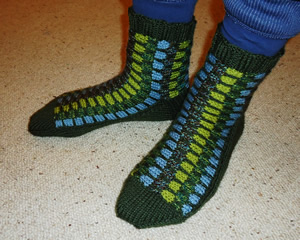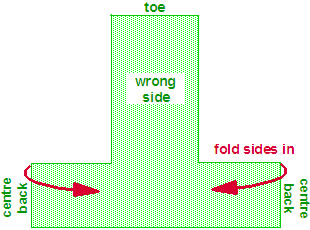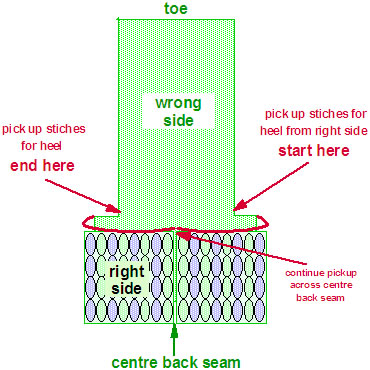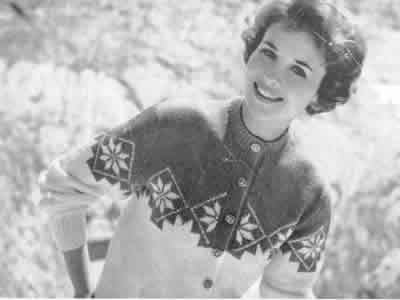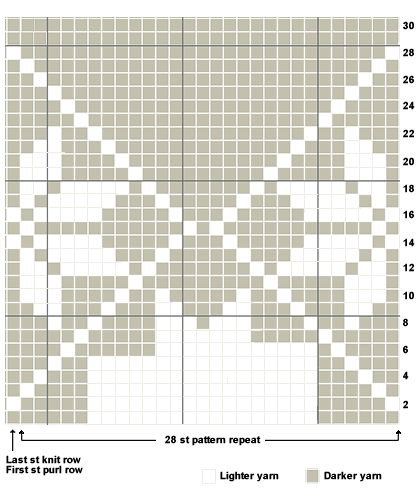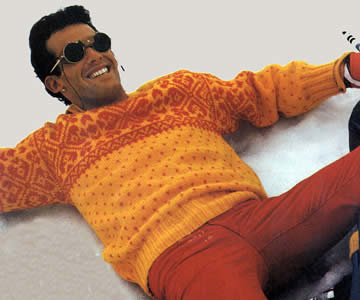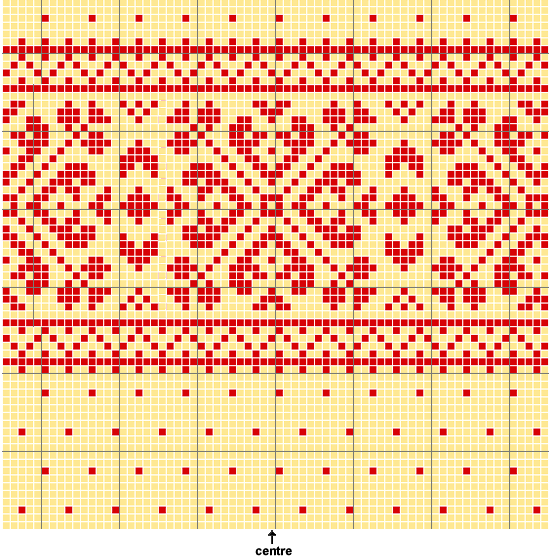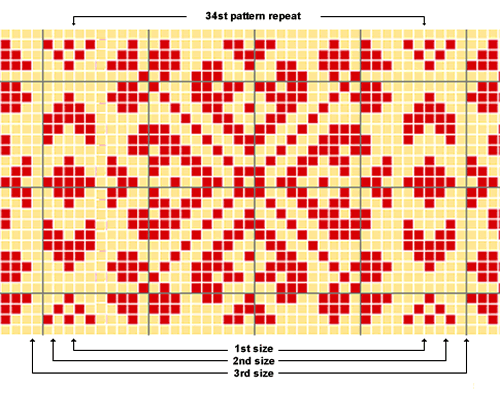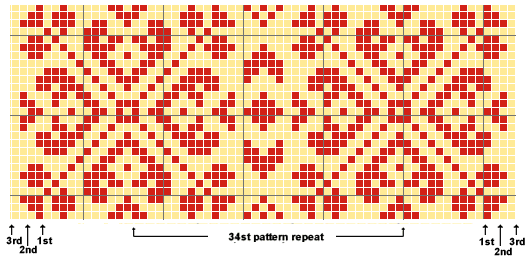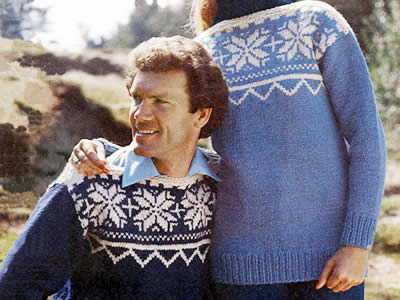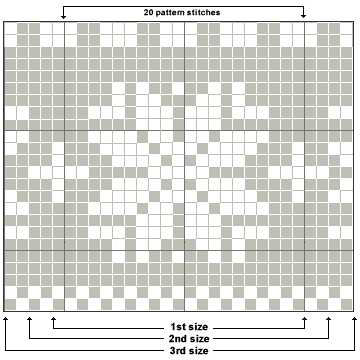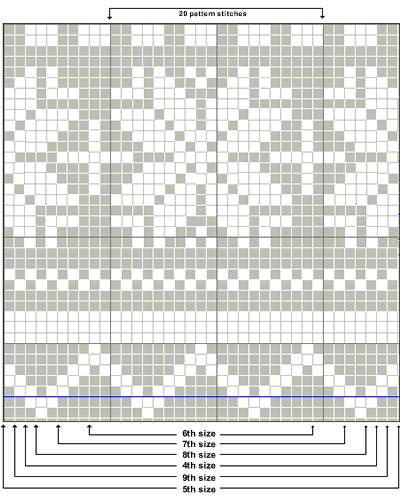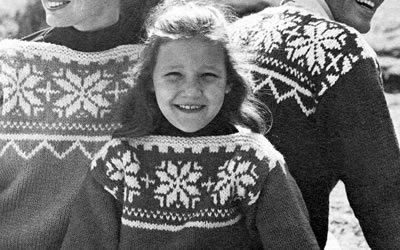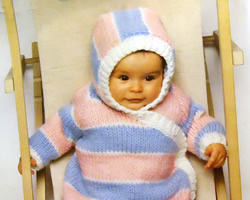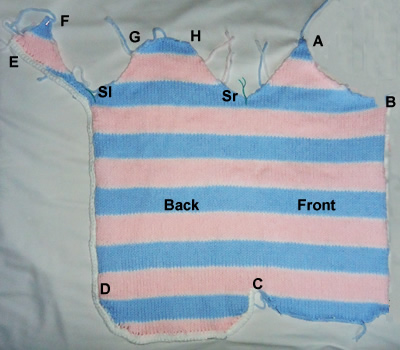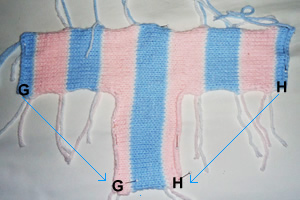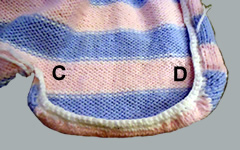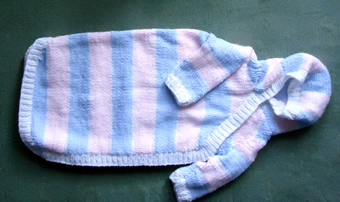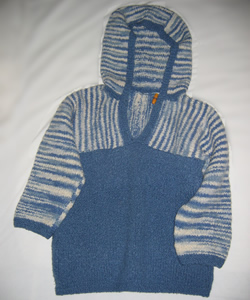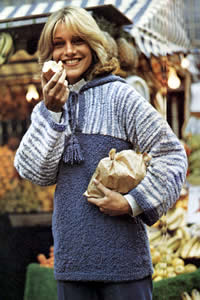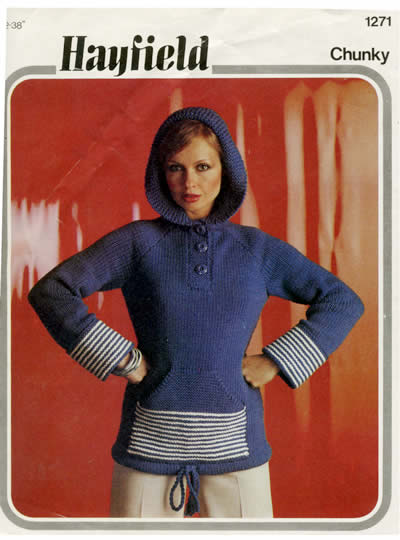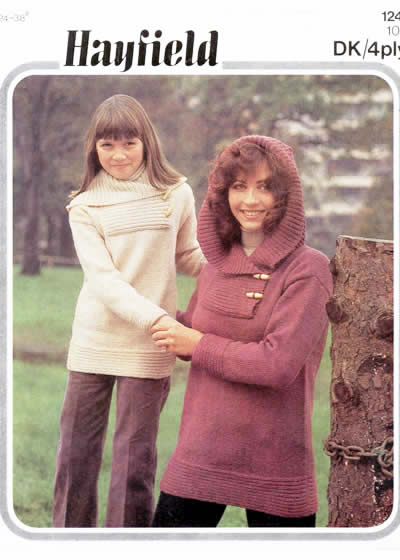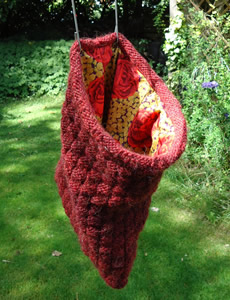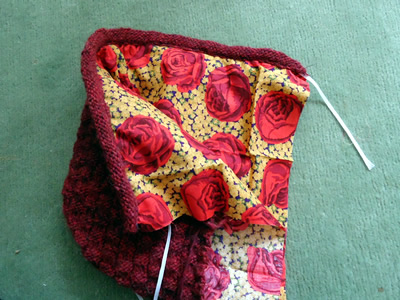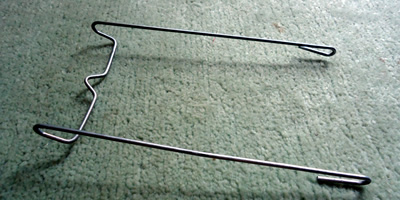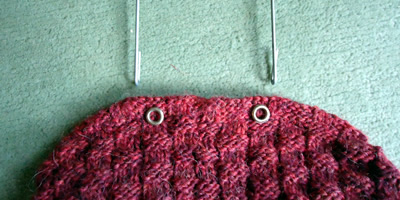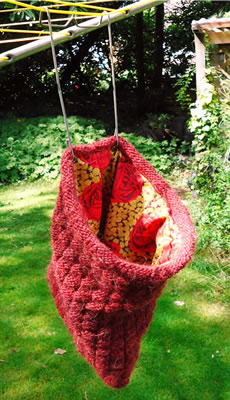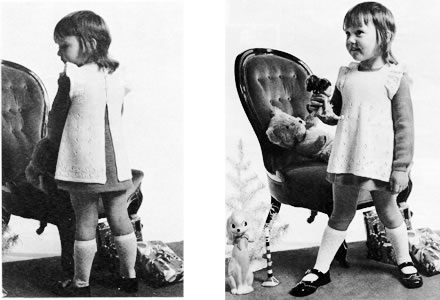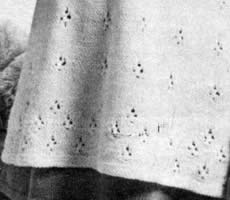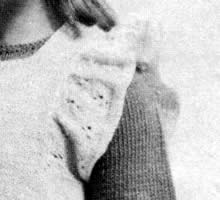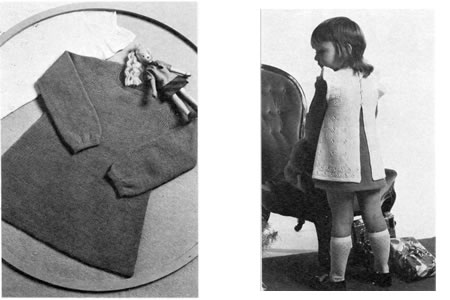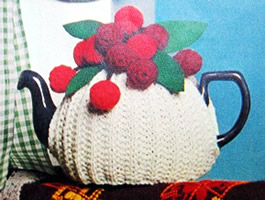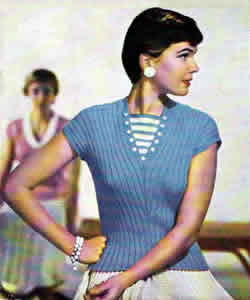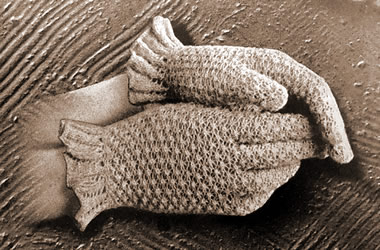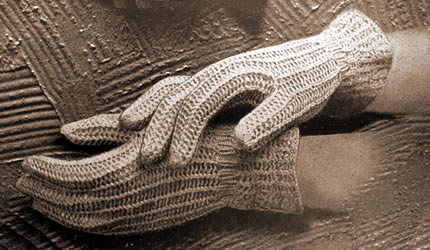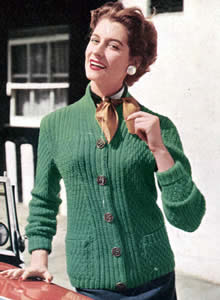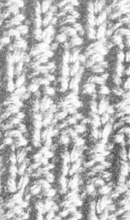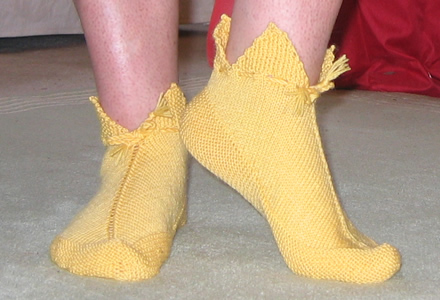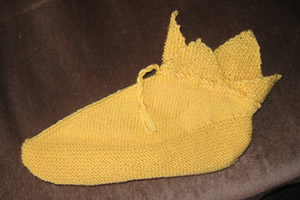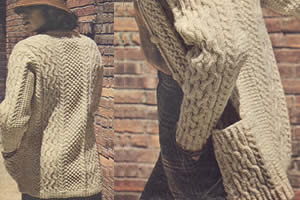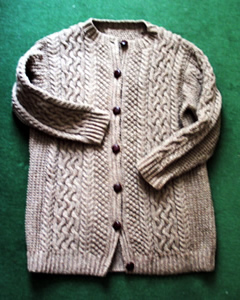Instructions.
Figures in brackets refer to larger sizes; where only one figure is given,
this refers to all sizes.
The Back
With No 9 needles cast on 98 (104 : 110: 116 : 122) sts.
1st row: P2, (kb1, p2) to end.
2nd row: K2, (pbl, k2) to end.
Repeat the last 2 rows 3 times more, then 1st row once, increasing 1st
at both ends of last row on lst, 3rd and 5th sizes.
Increase row: K8 (10 : 14: 16: 20),
kfb *p7, (k2, pfb) 6 times, k2, p7 *;
(k1, p1, then k1, p1 in next st) 4 times, k2; repeat from *
to *, kfb, knit to end. [118 (122 : 130 :
134: 142) sts]
Change to No 7 needles and pattern as follows:
1st row: (kb1, p1) 5 (6 : 8 : 9 :
11) times; * k7, (p2, k2) 6 times, p2. k7
*; p18; repeat from *
to *, (p1, kb1) to end.
2nd row: k10 (12 : 16 : 18 : 22);
* p7, (k2, p2) 6 times, k2, p7 *;
k1, (work k1, p1, k1 into next st, p3tog) 4 times, k1; repeat from *
to *; knit to end.
3rd row: (kb1, p1) 5 (6 : 8 : 9 :
11) times; * cp7, (p2, k2) 6 times, p2, cp7
*; p18; repeat from *
to *; (pl, kb1) to end.
4th row: k10 (12 : 16 : 18 : 22);
repeat from * to *
as 2nd row; k1, (p3tog, then into next st work k1, p1, k1) 4 times, k1;
repeat from * to *
as 2nd row; knit end.
5th row: (kb1, p1) 5 (6 : 8 : 9 :
11) times; * k7, p2, (c6L, p2) 3 times, k7
*; p18; repeat from *
to *; (p1, kb1) to end.
6th row: As 2nd row.
7th row: As 3rd row.
8th row: As 4th row
9th row: As 1st row
10th row: As 2nd row
11th row: (kb1, p1) 5 (6 : 8 : 9 :
11) times, * cp7, p2, k2, p2, (c6R, p2) twice,
k2, p2, cp7 *; p18; repeat from *
to *, (p1, kb1) to end.
12th row: As 4th row
These 12 rows form the pattern.
Continue in straight until work measures 20 ins, ending with right side
facing for next row.
Shape Armhole:
Cast off 4 (5 : 6 : 6 : 7) sts at the beginning of the next 2 rows;
then cast off 4 (5: 6: 7: 8) sts at the beginning of the following 2 rows.
[100 (100 : 104 : 106 : 110) sts]
Continue straight until armhole measures 7½ (7½ : 8: 8:
9) ins, ending after a wrong-side row.
Shape Shoulder and Neck:
Cast off 8 (8 : 10 : 11: 13) sts at the beginning of the next 2 rows.
Next row: Cast off 8, pattern until
there are 25sts on the right-hand needle, cast off 18, pattern to end.
Continue on the last set of stitches.
Next row: Cast off 8, pattern to
end.
Next row: Cast off 5, pattern to end.
Repeat the last 2 rows once more.
Cast off the remaining sts.
Join yarn to neck edge of remaining sts and work to match lst side, reversing
shapings.
Pocket linings (make 2)
[Editor's note: You
may note from the photograph that I omitted pockets on my cardigan - actually
I think it looks best with pockets, and I plan to add
them in later, but if you don't want them, simply leave out these
sections.]
With No 9 needles cast on 38sts.
1st row: K2, (p2, k2) to end.
2nd row: P2, (k2, p2) to end.
Repeat the last 2 rows for 5 inches, ending after 1st row.
Next row: P3, increase in the next
stitch, rib to the last 4 sts, increase in the next stitch, p3.
Leave the stitches on a spare needle or stitch holder.
The Right Front
With No 9 needles cast on 58 (61 : 64 : 67 : 70) sts.
1st row: K1, (kb1, p2) to end.
2nd row: (k2, pbl) to last st, k1.
Repeat the last 2 rows once more.
Next row (buttonhole): Rib3, cast
off 3, rib to end.
Next row: Work in rib, casting on
3sts over those cast off.
Work 3 more rows in rib, increasing 1st at the end of the last row on
the 1st, 3rd and 5th sizes. [59 (61 : 65 : 67 : 71) sts]
Increase row: K8 (10 : 14: 16: 20),
kfb; repeat from * to *
as increase row on back; (k1, p1, then k1, p1 in next st) twice, k2; turn,
leaving the remaining 8 sts on a safety-pin to work the buttonhole band
later.
Change to No 7 needles and continue to work on 60 (62 : 66 : 68 : 72)
sts as follows:
1st row: P10; repeat from *
to * as 1st row of back, then (p1, kb1) to
end.
2nd row: K10 (12 : 16 : 18 : 22);
repeat from * to *
as 2nd row of back; k1 (work k1, p1, k1 into next st., p3tog) twice, k1.
Keeping bramble stitch and cable pattern correct, decrease 1 stitch at
the end of the following 21st row, then the following 12th row.
Work 1 row.
Next row (place pocket): P10, slip
the next 40 stitches on to a stitch holder or spare needle;
work across the pocket lining stitches thus: k7, rib 26, k7;
then pattern across the remaining stitches.
Continue in pattern, decreasing 1 stitch at side edge on the following
10th row. Then continue straight on the remaining 57 (59 : 63 : 65 : 69)
stitches until work measures 13 inches.
Increase 1 stitch at the side edge on the next row and following 18th
row.
Then continue straight until work matches back to armhole, ending at side
edge.
Shape Armhole:
Cast off 4 (5 : 6 : 6 : 7) sts at the beginning of the next row, and
then 4 (5 : 6 : 7 : 8) stitches on the following alternate row. Continue
straight until armhole measures 5 (5 : 5½ : 5½ : 6) inches,
ending at the front edge.
Shape Neck:
Cast off 9 sts at the beginning of the next row; 3 stitches on the
following alternate row; and 2 stitches on the following 4 alternate rows.
Continue straight until armhole matches back to shoulder, ending at the
armhole edge.
Shape Shoulder:
Cast off 8 (8 : 10 : 11: 13) stitches at the beginning of the next
row, and 8 stitches on the following 2 alternate rows.
Work 1 row.
Cast off remaining 7 stitches.
The Left Front
With No 9 needles cast on 58 (61 : 64 : 67 : 70) stitches.
1st row: (P2, kb1) to last stitch,
k1.
2nd row: K1, (pbl, k2) to end.
Repeat the last 2 rows 3 times more, then 1st row once, increasing 1st
at the beginning of the last row on the lst, 3rd, and 5th sizes.
Increase row: Rib 8 stitches, and
leave these 8 stitches on a safety-pin to work the left front band later.
Continue the row: k2; (p1, k1, then p1, k1 in next st) twice; repeat from
* to * as increase
row on back; kfb; knit to end.
[60 (62 : 66 : 68 : 72) stitches]
Change to No 7 needles and pattern thus:
1st row: (Kb1, p1) 5 (6 : 8 : 9 :
11) times; repeat from * to *
as 1st row of back, then p10.
2nd row: K1, (work k1, p1, k1 into
next st., p3tog) twice, k1; repeat from *
to * as 2nd row of back; knit to end.
Continue in pattern as now set, and complete to match right front, reversing
shapings and the position of the pocket.
The Sleeves
With No 9 needles cast on 44 (44 : 50 : 50 : 50) sts.
Work 9 rows in rib as for the back welt, omitting the increases on the
last row.
Increase row: **
(k2, kfb) once (once : twice : twice : twice),
k2 **; repeat from *
to * as for the increase row on the back;
then repeat from ** to **.
[52 (52 : 60 : 60 : 60) sts]
Change to No 7 needles and pattern as follows:
1st row: (Kb1, p1) 3 (3 : 5 : 5 :
5) times; repeat from * to *
as for the 1st row of the back; (p1, kb1) to end.
2nd row: K6 (6 : 10 : 10) ; repeat
from * to *
as for the 2nd row of the back; knit to end.
Continue in pattern as now set, increasing 1 stitch at both ends of
following 5th row and every following 5th (5th : 6th : 6th : 5th) row
until you have 80 (80 : 86 : 86 : 92) stitches, working the increased
stitches into the pattern as end panels.
Continue straight until work measures 17 (17 : 18 : 18 : 18) inches.
For 1st, 2nd, and 3rd sizes, end with wrong side facing, and for 4th and
5th sizes end with right side facing to begin the next row.
Mark the ends of the last row (with a piece of coloured thread or a stitch
marker).
Shape Top:
Cast off 3 (4: 4: 5: 6) stitches at the beginning of the next 4 rows;
4 (4 : 5 : 4 : 4) stitches at the beginning of the next 2 rows;
and then 8 stitches at the beginning of the following 4 rows.
Cast off.
The Pocket Tops
With right side facing, slip the 40 stitches on the stitch holder for
the left front pocket on to No 9 needles.
1st row: K1, (k2tog tbl, p2) twice;
(kb1, p2) 8 times; k2tog tbl, p2, k2tog tbl, k1. [36 sts]
2nd row: K1, pb1, (k2, pb1) to last
stitch, k1.
3rd row: K1 (kb1, p2) to last 2 stitches,
kb1, k1.
Repeat last 2 rows once more.
Cast off in rib.
Repeat the process for the stitches on the stitch holder for the right
front pocket.
The Front Bands
With wrong side facing, slip the 8 stitches of left front on the safety-pin
back on to on to No 9 needles.
Work in rib as set, increasing 1 stitch at the end of the 1st row. [9
sts]. Continue in rib until band will fit front edge.
[Editor's note: I
have found it difficult to judge the fit of front bands knitted in this
way. My method now is that when I have knitted about the right length,
I test the length against the main body by laying the work flat and totally
relaxed with the front band laid in position up the front. When the front
band is about ½ to 1 inch shorter than the main body it fits nicely
into position very slightly stretched.]
Leave the stitches on a spare needle.
Mark the band with pins to indicate position of buttons; the first one
should be 4 rows up from the beginning and then position 5 more evenly
spaced between, allowing that top one will be in the neckband.
With wrong side facing, slip 8 stitches of right front on the safety-pin
back on to on to No 9 needles.
Increase in 1st stitch, and rib to end. [9 sts]
Complete to match left front band, working buttonholes at pin positions
thus:
1st row: Rib 3, cast off 3, rib to
end.
2nd row: Rib 3, cast on 3, rib 3.
The Neck Band
Join shoulder seams.
With No 9 needles and right side facing, rib across the 9sts of the right
band, pick up and knit 29 sts up right front neck, 37 sts round back neck,
29 sts down left front neck, and finally rib across 9sts of left front
band.
Work 6 rows in rib matching in with the bands, making the last (top)
buttonhole on the 4th and 5th rows.
Cast off in rib.
To Make Up
Join side seams.
Sew in sleeves, sewing the rows above the markers to the cast off groups
at the armholes.
Join sleeve seams.
Sew down pocket linings, and sides of pocket tops.
Sew on front bands and buttons.
|
Materials
9 (10 : 10 : 11: 11)
100g skeins Rowan Magpie Aran.
A pair each of Nos
7 (4½mm) and 9 (3¾mm) needles, and
2 cable needles.
7 buttons.
(I used wonderful smooth shiny leather buttons that look like conkers).
Tension
20sts to 4 ins in double moss stitch.
Size matters
The pattern is given in 5 sizes to fit chest:
32 (34 : 36: 38: 40) ins; length: 27 (27 : 27½: 27½: 28½)
ins;
and sleeve seam:
17 (17 : 18 : 18 : 18) ins.
Abbreviations
Increase: increase by knitting into front and back of the next
stitch.
k2tog: (decrease) knit 2 sts together.
p2tog: (decrease) purl 2 sts together.
kfb or pfb: knit or purl into front and back of stitch.
kb or pb: knit or purl into back of stitch.
tbl: through back loop
sl: slip
c6L: cross 6 left thus:
slip next 2sts on to cable needle, leave at front, slip next 2sts on to
cable needle and leave at back, k2, then p2 from cable needle at back,
k2 from cable needle at front.
c6R: cross 6 right thus: slip next 4sts on to cable needle, leave
at back, k2, then pass 2 purl sts back on to left-hand needle, purl these
2sts, then k2 from cable needle.
cp7: claw pattern 7 thus: slip next 2sts on to cable needle, leave
at back, k1, then k2 from cable needle, knit next st, slip next st on
to cable needle, leave at front, k2, then knit st from cable needle.
A word on the wool.
The original cardigan was knitted in a vintage Bainin yarn.
Disclaimer
(well...almost)
In transposing any pattern it is always a risk that errors will be introduced,
in spite of dedicated proof reading.
If you have any problems with this pattern, please
and I will try and assist.
|
